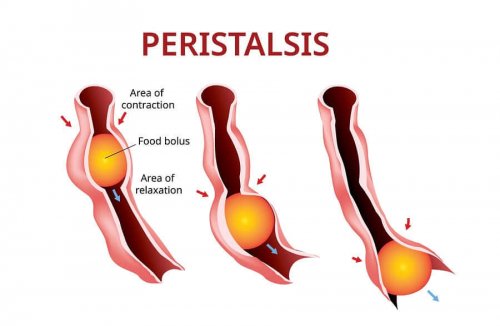Slow Transit Constipation: Everything You Need to Know

Slow transit constipation causes slow digestion and constipation in those who suffer from it. It usually manifests with intestinal transit alterations, making bowel movements slower than normal, which makes stool harder and causes painful defecation.
Overall, slow transit constipation can have many causes. For example, it’s often related to a sedentary lifestyle and an improper diet that’s low in fiber. It may even be due to intestinal imbalances or diseases. This makes it quite common.
Not being able to defecate properly can cause health and wellness problems. Therefore, in this article, we’ll explain everything you need to know about slow transit constipation and how to fix it.
What’s slow transit constipation?
As we mentioned above, slow transit constipation makes the muscles slower and weaker than usual. This makes stool transit very slow, causing stools to become harder. When this occurs, it’s logical for there to be constipation.
The person who suffers from this condition can’t defecate. And when they do, it’s painful. Also, it may even hurt their anus or rectum. Also, slow transit constipation is accompanied by abdominal distension and gas. In some cases, it can cause hemorrhoids due to the effort the person makes to try to defecate. In fact, these people often feel full and may even have bad morning breath due to intestinal gas.

You may like this article: Three Foods with Laxative Properties to Combat Constipation
What causes slow transit constipation?
Most of the time, this situation is caused by things that aren’t related to diseases, such as age. It happens more often in older people than in younger people. In turn, a sedentary lifestyle can also cause it. In fact, this is one of the most significant risk factors for developing slow transit constipation. Exercise makes the entire body active. Also, it helps the intestines move.
Unhealthy food and bad eating habits are also a common cause. Following a diet low in fiber and liquids increases the odds of suffering from this condition.
It’s also important to note that certain drugs are associated with this problem, especially the use of laxatives. Laxatives stimulate the intestine. Thus, if someone takes them for a long time, your intestines get used to them, generating the opposite effect.
Although less common, slow transit constipation can also be a symptom of a metabolic disease or nerve injury. It occurs when it affects any of the nerves that stimulate the movement of this organ, such as a spinal cord injury.

This article may interest you: Mango for Constipation: The Benefits and How to Prepare It
What you can do to fix it
The first thing you should do if you’re suffering from this problem is to consult your doctor. They’ll probably recommend dietary or lifestyle changes to help you solve the disorder naturally.
Firstly, it’s important to introduce more foods that are rich in fiber, such as fruits and vegetables. Also, experts recommended reducing your consumption of dairy products and processed foods. Likewise, it’s important to drink enough water.
Along with your diet, you should exercise daily. Simply walking an hour a day can lead to improvement. Some experts also recommend changing your position when you go to the bathroom to facilitate fecal evacuation. For example, try squatting.
If you still need laxatives, you should try to use natural laxatives. Green tea and certain fruits such as kiwi can help. Enemas are also a solution. However, you should only use them if your doctor recommends it.
Although slow transit constipation usually has a physiological cause and can be treated with small modifications, such as the ones we suggested here, it’s best to consult your doctor if you don’t improve. They’ll request relevant tests and determine the underlying cause.
All cited sources were thoroughly reviewed by our team to ensure their quality, reliability, currency, and validity. The bibliography of this article was considered reliable and of academic or scientific accuracy.
- Intestino perezoso: síntomas, nutrición y remedios naturales. (n.d.). Retrieved January 19, 2020, from https://es.blastingnews.com/salud-belleza/2016/01/intestino-perezoso-sintomas-nutricion-y-remedios-naturales-00745919.html
- Los peligros de un intestino “perezoso” | CuidatePlus. (n.d.). Retrieved January 19, 2020, from https://cuidateplus.marca.com/enfermedades/digestivas/2010/10/04/peligros-intestino-perezoso-20676.html
- Síndrome del intestino perezoso: todo lo que debes saber sobre este problema digestivo. (n.d.). Retrieved January 19, 2020, from https://www.elespanol.com/ciencia/salud/20191218/sindrome-intestino-perezoso-debes-saber-problema-digestivo/452705267_0.html
This text is provided for informational purposes only and does not replace consultation with a professional. If in doubt, consult your specialist.








